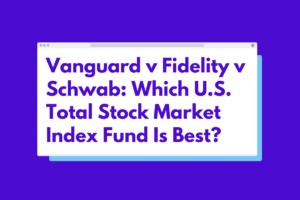So I’ve had a 401k for about 13 years and over that time I’ve made some mistakes, I’ll admit. And today I’m going to share with you some of those mistakes. So if you are just starting on your journey with your 401k or 403b for that matter, then you definitely want to pay attention through to the end of this post to learn some of the mistakes that I was making, including other ones that I thankfully was able to avoid.
I think the first one is a really important mistake that you definitely want to avoid if you have a 401k and that’s not investing up to the company match. You want to be sure to set that contribution amount to match at least whatever the company that you work for is providing you.
So if they’re going to offer you a 2% match dollar for dollar, then you definitely want to invest at least 2% into your 401k. I know some other companies offer 4% match, 5% match, even some. Companies will offer a 6% match dollar for dollar. So whatever the case may be, if it’s within financial means, if it makes sense for you financially, you definitely want to invest up to the company match, because if you are not investing in your 401k up to the company match, well, that is money that you are leaving on the table because that 2%, 3%, 4% that the company is offering you that could have been compounding will not happen.
And you’re going to miss out on that opportunity to be able to have a greater nest egg when you retire. So when I talk to folks out there and they ask me, how much should I be investing? I have some debt, you know, I’m still working on paying off some student loans, a credit card bill, a car note. What I tell them, if investing up to the match is not going to hurt you financially from Taking care of those bills and those debts, then why not?
That’s free money. That’s part of your work compensation. And I want you to take advantage and earn as much money as you can, whether that’s today or whether that’s going to be compounding throughout the years for you to be able to build that retirement fund in the future. The second 401k mistake that you should avoid is one that I see so many family friends making all the time.
And that is quote, unquote, moving to safer funds in bear markets. It’s no secret by now, hopefully if you are. Part of this channel. If you’re not, make sure you subscribe that when there is a down market, we know that to be an opportunity to continue to buy more and increase how much we’re contributing to our 401k and investment accounts, because we understand that the index funds, the mutual funds that we are buying in that time is actually being offered to us at a discount, and that could be the opportunity.
To be able to buy more during a bear market. And it’s very important that we understand that because if you try to sell the funds that you have, when the stock market is low, well, you’re going to have to try to catch it before it starts going up. And that is a fool’s errand. No one can consistently time the market.
That’s why I personally embrace the education of dollar cost averaging, just continuing to buy whatever it is I’m buying at the same price. Each month, every month, and that way I take advantage of those low bear markets. And yes, during the bull market, some people will say, well, that’s the time to scale back and just watch your money grow.
Maybe go buy another fund or a different type of fund that is low. And that can be a strategy that could work for you. But personally, I’m just continuing to invest the same amount. Each time for the last 13 years, this has proven to be a very good strategy. And one that many in the academic field of investing continue to educate people with the next 401k mistake that you might get upset about.
If you don’t know about this is. Exactly how much you can contribute to your 401k. A lot of people don’t realize this, but the actual contribution limit in 2023 is 66, 000 for the employee and employer combined. And if you’re age 50 or older, you’re eligible for an additional 7, 000. 500 dollars in what’s called catch up contributions.
So that gives many folks who are just a little bit older, 73, 500 that they can contribute between them and their employer into their 401k. And I am going to talk about those contribution limits in a future video more in detail, but that is something that I want you to understand that you’re not just limited to the 22, 500 of Pre tax contributions or Roth contributions that you typically will see a lot of people talk about.
You can actually invest beyond the 22, 500. You just won’t be able to get that tax benefit. And so once you reach that pre tax limit of 22, 500 or whatever it’s going to be in the future, well, depending on your plan, you will be able to contribute to your 401k beyond that 22, 500. But it would be with.
After tax money. So kind of like a Roth IRA in a sense, but with the 401k, you have to be careful how your 401k is set up because some 401k plans do have an after tax Roth account or just a regular after tax bucket where you are going to get taxed when you do the withdrawals. But if you have that after tax Roth 401k, well, you can contribute that after tax money and be able to watch that money grow.
And when you start taking the money out. That’s when you’re able to get that money tax free. So as of right now, I’m definitely working on a video that’s going to talk more about this in detail. So make sure you subscribe so you don’t miss that video. The next mistake I see people make is when they leave the company that they work for, what to do with that 401k.
There are several options that you have. You can actually. Leave your 401k with the company that you worked for the organization that you worked for. And that may be a better option than simply taking it and rolling it over to an IRA, which is what a lot of people like to do, but it’s just not black and white.
For some people, you may have some of the best investments available. In that 401k, and if you have really, really great investments in that 401k, then, you know, you’re probably not going to want to move it unless it’s going to be hard to access in the future. And you kind of foresee that, and you may want to just go ahead and do a rollover IRA transaction where you go open a rollover IRA account, whether it’s at Fidelity or Vanguard and initiate that transfer.
From your 401k over into the rollover IRA. So that way you avoid any problems and you’ve established that connection between the 401k and your new rollover IRA. And the transaction happens without having you have to deal with moving the money yourself. And that eliminates any risks that could come with having to pay a penalty or any taxes that you might owe because you have the money and you may just get caught up in your own life and forget to do that.
Now, this mistake is one that is so critical that I see a lot of people, especially young people, not realize they’re making. And I was one of those people who made it as soon as I got hired into the company I work for. And that is choosing high cost mutual funds. Not all of the funds in your 401k are created equally.
You’re going to see some. That’s a index fund. You’re going to see some that say mutual funds. And when you look into the details of each of those funds, you’ll see something called an expense ratio. And personally, I try not to invest in anything that has an expense ratio of greater than 0. 10% or 10 basis points, because anything greater than that.
Starts to eat away at the gains that my investments are making for me. So that’s why I like a lot of the education around having index funds and just keeping them low costs. So anything that starts with a 0. 0 something percent, 0. 02%, 0. 03%, 0. 04% for me has worked out. So great has worked out so amazing.
And I do like the fact that I am making whatever the markets make. I am not relying. On a person to have to try to beat the market because what we’ve seen from history and the academics have taught us that does not happen consistently year over year over year. The market always wins over the longterm.
And I just think that’s an important part for young investors to know, especially early on. That index funds could be a better opportunity for you as you learn and educate yourself more about index funds and mutual funds and all the different types of asset classes, international, large cap value, small cap value, mid, so many different terminologies within investing to learn that it’s actually pretty basic once you get the hang of it, but.
For me, as I stuck with index funds, this gave me that opportunity to learn more about all these other funds that were in my 401k that were options. And within the 15 or 20 options that I have in my 401k, believe it or not, I am only invested in two index funds and that is Fidelity’s total stock market index fund because my 401k is with Fidelity and with Fidelity’s total international market index fund.
That has served me so well. Yes, the market’s gone up and down, up and down, but like I said before, I stick with my dollar cost averaging strategy of investing and that has worked for me. Now, believe it or not, a 401k isn’t the only investment account that you need. And the video below will teach you more about the other accounts that I like to build wealth with.
![Read more about the article The Importance of Investing Early [Start Now!]](https://habeshafinance.com/wp-content/uploads/2018/10/importance-of-investing-early-man-walking-300x200.png)

